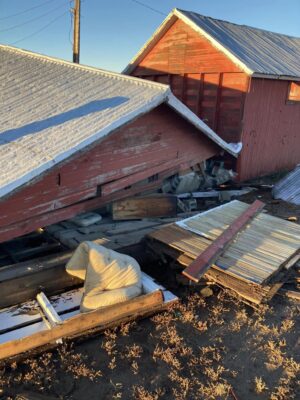By Trip Jennings, New Mexico In Depth | February 19, 2020
As the annual legislative session races to an end Thursday, think of the New Mexico Legislature as an industrial-strength strainer. Only a portion of bills will pass through.
But some lawmakers are saying too many bills being filtered out come from communities that are home to students identified in the landmark Yazzie Martinez education lawsuit as shortchanged in the state’s public schools.
The House of Representatives and Senate may be wrangling over last-minute changes to the state budget, but raging behind the scenes is a debate over whether the spending plan is responding to the court order that demands New Mexico educate its at-risk students better.
Many advocates for those students had viewed 2019 and 2020 as an opportunity to re-envision the state’s public education system after a decade of stagnation. The Great Recession in 2008 hobbled the state’s ability to transform public schools. On its heels were eight years of Republican Gov. Susana Martinez’s emphasis on high-stakes testing and a one-size-fits-all mentality that clashed with educators and the state’s ethnically and economically diverse communities.
Then came Judge Sarah Singleton’s historic ruling in 2018 that castigated the state for not doing right by most of its public school students, converging with an influx of cash from the oil and gas sector into state coffers and a new Democratic governor calling for an education “moonshot.” Suddenly the moment for change looked imminent.
But as the 2020 session winds down, some wonder where the transformational change is even as the state pumps hundreds of millions into education. And they’re pointing fingers at the status quo in the Legislature.
“If we are still on this moonshot, the moonshot has missed the Martinez kids and the Yazzie kids,” Rep. Derrick Lente, a Democrat from Sandia Pueblo, said in his legislative office.

Other lawmakers echo Lente’s comments.
“Tell me if I’m wasting my time,” a frustrated Rep. Tomas Salazar, Democrat of Las Vegas, asked during a recent legislative committee hearing about bills he’s been pushing for two years.
Lente and Salazar are part of an increasingly loud chorus of voices in the Legislature who say the state’s process for creating its multi-billion-dollar spending plan each year excludes the people who know the most about how to fix the problems identified by the Yazzie-Martinez lawsuit.
During the months when the Legislature is not in session, Lente’s and Salazar’s argument goes, the state budget is largely crafted by a select group of lawmakers and staff of the Legislative Finance Committee, leaving out perspectives from low-income communities of color, including many of New Mexico’s tribal nations.
Sen. Bill Soules, a Las Cruces Democrat who chairs the Senate Education Committee, agreed, but said the problem is much larger.
“Everybody in the Legislature who is not on Finance feels like the things that are important to them are not listened to,” Soules said. “… there is not a lot of communication. Members feel like they don’t have much input in the budget making process.”

Public schools and higher education make up more than half the state’s $7.6 billion draft budget. It’s unclear, however, how much input lawmakers on the Legislature’s education committees have into how to allocate money.
There’s still time for more of the priorities championed by Lente and Salazar to get funded in the state budget with 24 hours to go. But even if they do, many members of the House and Senate education committees say the problem will outlast this session, and they are calling for more collaboration and communication between those who write the budget and those who set education policy.
When lawmakers show up in Santa Fe each January, it’s frustrating to find a draft state budget that is already baked, said Rep. Rebecca Dow, a Republican from Truth or Consequences and a member of the House Education Committee.
“What I’ve heard and what I believe to be true is that at the state level, someone other than the lawmakers, other than the members of (the Legislative Education Study Committee), other than members of education, is creating a budget that is driving policy,” she said in an interview.
Frustrations made public
The tensions over the budget-making process flared earlier this month during a meeting of the House Education Committee.
For much of the two-hour meeting lawmakers quizzed David Abbey, the top staff person at the Legislature’s budget arm, the Legislative Finance Committee, and Rachel Gudgel, staff director for the Legislative Education Study Committee.

The discussion centered around a perceived lack of input into the annual state budget by lawmakers who serve year in year out on education committees learning and creating education policy and spending priorities.
It was her impression from watching the budget-writing process this session, Dow said, that state officials are ignoring “what communities are asking for” – especially rural and low-income communities of color.
Abbey responded, saying communities with small school districts, including those with large Native American populations, would get flexibility in the budget to address those concerns.
That prompted Rep. Christine Trujillo to chime in.
The Albuquerque Democrat said she was troubled that the House Education committee was busy deliberating education bills while “the finance committee is making decisions that we are not a part of.”
Rep. Andres Romero, the Albuquerque Democrat who chairs the House Education Committee, tried to demystify the budget-making process, asking Abbey to review how the House Appropriations and Finance Committee arrives at its spending recommendation for public schools.
The House appropriations committee uses the LFC spending proposal put together before the session begins as its template.
A subgroup of the House Appropriations Committee privately discusses public schools and makes a recommendation to the full committee, Abbey explained. The subgroup’s discussions aren’t subject to New Mexico’s open meetings law because it doesn’t have a quorum of the full House committee.
The full appropriations committee then holds public hearings based on the recommendation, Abbey said.
That didn’t seem to sit well with Romero.
Dow then spoke up. She pointed to Lente’s bills, which remain mired in the legislative committees process.
Lente’s bills would earmark money to strengthen tribal education departments around the state so they could develop “culturally appropriate” curriculum and evaluations for teachers and programs. They’d also earmark millions of dollars for tribal libraries and afterschool and summer school programs as well as help to increase access to high-speed internet. Many tribal communities, geographically isolated, lack high speed internet in an era when more schoolwork is done online.
Several of Lente’s bills have won endorsement from New Mexico’s tribal nations. “We met with every single Native American community,” Lente said. “For them to all come together in one consensus, it’s unprecedented.”
Dow worried that the state’s policy makers were repeating history in not listening to what tribal communities were telling them, she told Abbey and Gudgel. Parents worried about their 3- and 4-year-olds being on a bus for extended periods to reach programs outside their communities, she told the committee.

“That hit me hard,” the Republican lawmaker said, before recalling an anniversary event she attended for Rehoboth Christian School near Gallup several years ago. The school took full-page ads out in newspapers apologizing to the state’s tribal communities for its part in historically removing native children from their communities, putting them in boarding schools, and making them dress and speak like white people.
“And yesterday Derrick Lente, Chairman Lente, was before this committee saying the same thing. He was saying … you didn’t listen to my people,” Dow said.
For her part, Dow has sponsored legislation that she hopes will mandate a study of the State Equalization Guarantee, the per-student funding formula the state uses to distribute dollars to 89 school districts and its charter schools.
“Is the funding formula responsive to at-risk minority, indigenous, low-income, special needs” students, Dow asked. “The answer is no.”
A Known History
Lente admitted to feeling dismayed that his bills aren’t grabbing more attention, but it’s not a shock. Many mirror decades-old ideas.
From the 1960s on, report after report has documented the dismal education of the state’s Native American communities. Too few resources. Culturally inappropriate curriculum. And time and again, the reports have called upon educators, administrators and policy makers to heed recommendations from communities that predate the appearance of Europeans.
The Kennedy Report of 1969, a federal review of indigenous education, acknowledged the classroom was a tool of assimilation for indigenous children for much of this country’s history.
Then came 1991’s Indian Nations at Risk report by the U.S. Department of Education. And a 2006 Legislative Finance Committee report that identified challenges and recommended solutions, followed by a 2010 report commissioned by the state Public Education Department titled Indian Education In New Mexico, 2025.
But, for the most part, not a lot has changed, advocates and tribal representatives said.
What’s needed is listening by policy makers so they will understand why it’s important to act on bills like Lente’s, they added.
They need “to go into our communities and talk one on one to our school boards, with members, with faculty, with students, to hear what they need,” said Trenton DeVore, a young man from Jemez Pueblo who was visiting the Roundhouse on a recent Monday to lobby lawmakers.

Bernalyn Via of the Mescalero Apache tribe agreed, saying her community wanted “an education that reflects who we are as Mescalero Apaches.
The state’s native peoples have plenty of experience educating their own communities, said Vernon Lujan of Taos Pueblo. They’ve been doing it since “before Europeans came to this continent.”
“We had ways of teaching our children our languages, our culture, our religion, our warring techniques, our trading techniques, all kinds of interactions, social interactions,” he said. “It was all a part of cultural education.”
The question that frustrates Lente and others is why the state didn’t listen to previous warnings and how some of this year’s debate seems like rehash from previous eras.
It’s been well known for decades that New Mexico’s teaching ranks don’t look like New Mexico, which has the highest percentage of Hispanics in the United States, and one of the highest percentages of Native Americans, who make up 11% of the state’s population.
Judge Singleton noted in 2018 that fewer than 2% of teachers in the state’s public schools are Native American compared to the nearly 11% among students. That’s down from the 2.5% in a 2006 Legislative Finance Committee evaluation of implementation of the 2002 Indian Education Act.
Gov. Michelle Lujan Grisham in December acknowledged that New Mexico continues to struggle “to get the cultural and linguistic requirements of every student met.”
But those weaknesses were registered in the same 2006 report, when the authors wrote that “research indicates that low achievement of Indian children is largely due to irrelevant (culturally inappropriate) content standards, school organization, instruction and testing.”
Another 2010 report – Indian Education in New Mexico, 2025 – noted successful schools “make curriculum relevant to Native students’ lives,” including by integrating “Native history, science and philosophy in all courses, for the benefit of all students.

Nearly 15 years ago, authors of the 2006 legislative evaluation report lifted up a Montana law passed by that state’s Legislature in 1999. The law called “for all students to be provided an opportunity to learn about Native American culture, for all school personnel to have an understanding of Indian tribes to relate to Indian students and parents, and for every educational agency to work with Montana tribes.”
Success of the effort relied “on the entire educational community not just schools with high populations of American Indians,” the report’s authors wrote.
According to advocates, that recommendation was never followed.
Two years ago, in an open letter to Native leaders, an assistant secretary for Indian education at the state Public Education Department noted the unheeded recommendations and acknowledged the leaders’ “emotional and justified anger.”
“I have come to a clarifying realization that what is obvious to you, the continuation of a long history of injustice and inequity, is not always easily understood by others,” Latifah Phillips, a member of the Tohono O’odham nation, wrote to the leaders of the state’s tribal nations.
Months later, Singleton’s ruling in the Yazzie Martinez case put an exclamation point on that sentiment.









